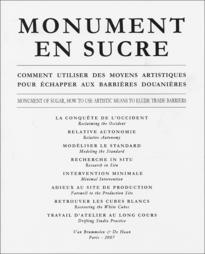MONUMENT EN SUCRE : COMMENT UTILISER DES MOYENS ARTISTIQUES POUR ÉCHAPPER AUX BARRIÈRES DOUANIÈRE
"Monument en Sucre / Monument of Sugar, contains the translated title sequences of the 16mm film essay Monument of Sugar, how to use artistic means to elude trade barriers, which is part of the installation Monument of Sugar. Monument of Sugar is an installation consisting of a 16mm silent film essay and a floor sculpture. As with many projects of Lonnie van Brummelen and Siebren de Haan, this one also explores the intersection of social and political issues with artistic and aesthetic practices. Following the discovery that a large amount of European sugar ends up outside of Europe, the artists embarked on a research trip to investigate the European subsidized sugar trade which took them from Holland to Poland and finally to Lagos, Nigeria. They decided to reverse the flow of the subsidized commodity by buying European excess sugar cheaply in Nigeria and shipping it back to Europe. To elude the European trade barrier for sugar imports they would transport the sugar as a ’monument’. The material result of their research, two groups of sugar modules, is shown together with a dialectical film essay which charts the artists’ travels and investigations into the sugar trade. Slowly running titles narrate the obstacles faced by the artists in their quest to find out more about the sugar trade route as well as the difficulties encountered in the production of their ’monument’. These running titles, or ’Garamond landscapes’, as the artists call them, are intersected by documentary footage exploring, in long slow takes, hidden production landscapes of global trade, like crop fields, sugar refineries, flow-bands, harbours, and the different sites where the artists performed their drifting studio practice. Monument of Sugar is shown together with a work by Lawrence Weiner from 1969. In agreement with the ideas of many conceptual artists who gained international recognition in the late 1960s and early 1970s, Weiner’s works challenges the myth of artistic authorship and undermines the ’prestige’ of the artwork. The physical art object ’by virtue of being a unique commodity’ is rejected by Lawrence Weiner as ’something that might make it impossible for people to see the art for the forest.’ Instead, he opted for art which consists solely of language, which he defined as ’the most non-objective thing’. Nevertheless, the subjects of his statements are often materials or physical processes, like AN AMOUNT OF PAINT POURED DIRECTLY UPON THE FLOOR AND ALLOWED TO DRY or DIREKT UNTER DAS LICHT GESTELLT. His Statements are lettered in a standard typeface, phrased with impersonalised syntax, and the lettering need not be done by the artist himself, as long as the work is executed according to the minimal instructions by the artist. In transferring 1000 euros worth of sugar from one continent to another, Van Brummelen and de Haan’s work seems to poignantly echo Weiner’s 1969 Statement." (Argos)
Monument en sucre : Comment utiliser des moyens artistiques pour échapper aux barrières douanière
19,4x 15,7 cm, 22 pages, English / French
- €1,00
- Grootte22 p.
- Jaar2007
- Publicatie info
- Palais de Tokyo : Paris
- Auteur(s)
- Lonnie Van Brummelen
- Siebren De Haan
- Gerelateerde evenementen
